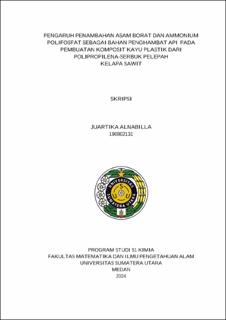| dc.description.abstract | Research on the manufacture of plastic wood composites from polypropylene-oil palm frond powder (SPS) with the addition of AB/APP fire retardant has been carried out and this study aims to improve its resistance to fire. The manufacture of wood plastic composites was carried out in four stages. Stage 1 is the alkalization process. Stage 2 was the preparation of PP-g-MA with a ratio of 92:6. The resulting PP-g-MA was subjected to FT-IR testing. Stage 3 was the manufacture of plastic wood composites from polypropylene-oil palm frond powder (SPS) with the percentage ratio of SPS:PP:PP-g-MA (30:64:6, 35:59:6, 40:54:6)%. Molding is done using a hot press at 170°C and then testing the physical and mechanical properties which include density, moisture content, thickness development, bending test. From the results of testing the physical and mechanical properties of the best ratio obtained at then testing the physical and mechanical properties including density, moisture content, thickness development, bending test. From the results of testing the physical and mechanical properties of the best ratio obtained at SPS: PP: PP-g-Ma is (35: 59: 6) % with a density value of 0.79 g / cm3, moisture content of 1.9%, thick development of 2.32%, bending stress of 41.868 MPa and elastic modulus of 247.632 MPa. Stage 4 was the manufacture of plastic wood composites with the addition of boric acid (AB) and ammonium poliophosphate (APP). The optimum plastic wood composite added with AB/APP fire retardant was then pressed using a hot press at 170°C. then flammability testing was carried out with UL-94. It was found that the burning rate of plastic wood composite before the addition of flame retardant was 26.6 ± 0.8 mm/min and after the addition dropped to 21.9 ± 0.4 mm/min. While the Burn time value before the addition of fire retardants was 169.3 ± 3.6 seconds and after the addition became 205.3 ± 3.1 seconds. So there is a significant increase in the fire resistance of wood plastic composites | en_US |


